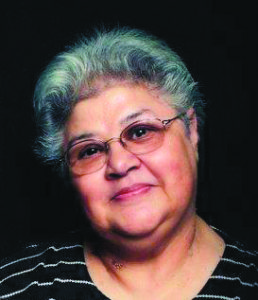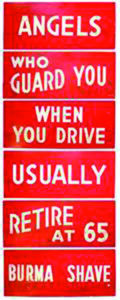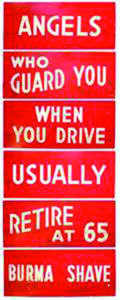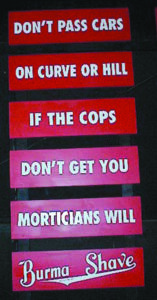


 Some of my favorite childhood memories were the road trips my parents and I took from California to Arizona, every summer, to visit family. These were the days before President Eisenhower’s Interstate Highway System was created, so motor travel was conducted on “two-way” county roadways, some better maintained than others.
Some of my favorite childhood memories were the road trips my parents and I took from California to Arizona, every summer, to visit family. These were the days before President Eisenhower’s Interstate Highway System was created, so motor travel was conducted on “two-way” county roadways, some better maintained than others.
Once the games of “what do you see in that cloud?” or “how many different states’ license plates can you see?” it seemed to take forever to make that annual journey.
The only break that I longed to see were the ubiquitous, humorous, little red “Burma Shave” signs that were posted in seemingly random places along the highways.
Burma-Shave was a brushless shaving cream introduced in 1925 by the Burma-Vita company of Minneapolis, Minnesota. Burma-Shave roadside signs first appeared on U.S. Highway 65 near Lakeville, Minnesota, in 1926, and remained a major advertising component until 1963 in most of the contiguous United States.

 Typically, six consecutive small signs would be posted along the edge of highways, spaced for sequential reading by passing motorists. The last sign was almost always the name of the product.
Typically, six consecutive small signs would be posted along the edge of highways, spaced for sequential reading by passing motorists. The last sign was almost always the name of the product.
This use of a series of small signs, each of which bore part of a commercial message, was a successful approach to highway advertising during the early years of highway travel, drawing the attention of passing motorists who were curious to learn the punchline.
Some of the signs featured safety messages about speeding instead of advertisements.
In 1929, the prosaic ads began to be replaced by actual verses on four signs, with the fifth sign merely a filler for the sixth:
- Every shaver / Now can snore / Six more minutes / Than before / By using / Burma-Shave
- Your shaving brush / Has had its day / So why not / Shave the modern way / With / Burma-Shave
- No matter / How you slice it / It’s still your face / Be humane / Use / Burma-Shave
- Keep well / To the right / Of the oncoming car / Get your close shaves / From the half pound jar / Burma-Shave
Safety messages began to increase in 1939, as these examples show.
- Hardly a driver / Is now alive / Who passed / On hills / At 75 / Burma-Shave
This “free” promotion attracted a lot of attention:
- Free – free / a trip to Mars / for 900 / empty jars / Burma-Shave
 Arlyss French, owner of a Red Owl grocery store, did submit 900 empty jars; the company at first replied: “If a trip to Mars / you earn / remember, friend / there’s no return.” Then Burma-Shave, on the recommendation of Red Owl’s publicity team, withdrew the one-way offer and instead sent Mr. and Mrs. French on vacation to the town of Moers (often pronounced “Mars” by foreigners) near Duisburg, North Rhine-Westphalia, Germany.
Arlyss French, owner of a Red Owl grocery store, did submit 900 empty jars; the company at first replied: “If a trip to Mars / you earn / remember, friend / there’s no return.” Then Burma-Shave, on the recommendation of Red Owl’s publicity team, withdrew the one-way offer and instead sent Mr. and Mrs. French on vacation to the town of Moers (often pronounced “Mars” by foreigners) near Duisburg, North Rhine-Westphalia, Germany.
The final slogan appeared in 1963:
- Our fortune / Is your / Shaven face / It’s our best / Advertising space / Burma-Shave
At its peak, Burma-Shave was the second highest-selling brushless shaving cream in the US. Sales declined in the 1950s, and in 1963 the company was sold to Philip Morris. Their well-known advertising signs were removed at that time.
As the Interstate system expanded and vehicle speeds increased, it became more difficult to attract motorists’ attention with small signs. When the company was acquired by Philip Morris, the signs were discontinued.
People reacted to this story.
Show comments Hide commentsI remember those Burma Shave signs. As a child, we always got a big laugh out of them when we took road trips. We took turns reading them out loud. That is a wonderful memory.